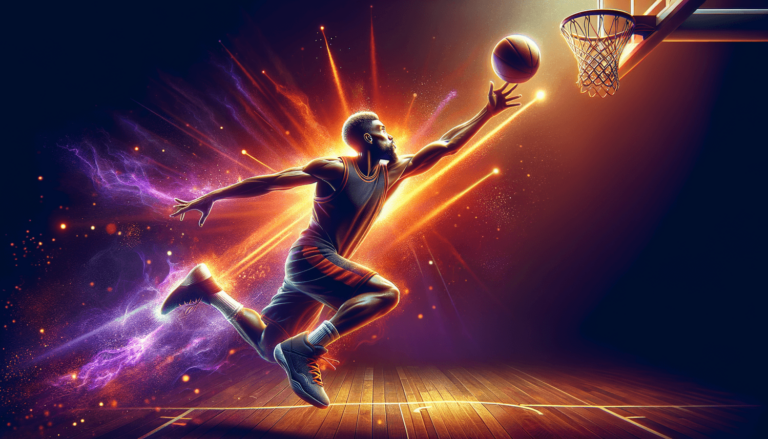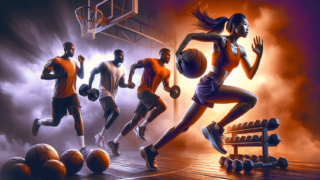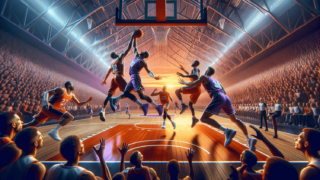
Welcome to the fascinating world of basketball, where your understanding of the game is about to get a slam dunk upgrade! We’re here to talk about the catch and shoot, an essential maneuver that can swiftly transform a good team into a great one. If you’ve been itching to know more about this impressive technique, you’ve come to the right place. With just the right blend of fun and professionalism, we’ll delve into the nuances, mechanics, and strategic benefits of the catch and shoot—all in the spirit of elevating your basketball IQ to hall of fame heights.
What’s a Catch and Shoot in Basketball?
A catch and shoot in basketball is an offensive move where a player catches a passed ball and quickly shoots it without dribbling. This technique uses the element of surprise to outpace defenders, allowing the shooter to capitalize on open space, and relies on efficient off-ball movement and precise passing from the teammates to be successful.
Mastering the Art of the Catch and Shoot
The catch and shoot is an invaluable skill for any basketball player looking to elevate their game. While it might seem straightforward, there’s more to it than simply catching and shooting. To help you ace this fundamental tactic, we’ll dive deep into its various elements and provide useful tips that can be readily applied on the court.
The Mechanics of the Catch and Shoot
Paying close attention to the mechanics of the catch and shoot will help you perfect this technique, putting you on the path to becoming an excellent jump shooter.
Feet and Body Positioning
Footwork is crucial in a catch and shoot situation. As you anticipate receiving the pass, maintain a slight bend in your knees, keeping your feet shoulder-width apart. Your lead foot should be slightly forward, and your body should be squared up to the basket to maintain balance and maximize shooting accuracy.
Catching Effectively
As the pass comes your way, extend your arms towards the ball with your shooting hand slightly behind the ball and your off-hand in a supportive position. Use your fingertips to catch the ball, absorbing its momentum smoothly, and avoid grabbing it haphazardly, which can disrupt your overall shooting rhythm.
Shooting Mechanics
Once the ball is in your hands, it’s time for the actual shooting motion. Using your legs to generate power and your arms to aim, take a fluid, upward jump while keeping your shoulders relaxed and square to the basket. Release the ball at the peak of your jump with a swift snap of your wrist, creating a backspin effect that will help stabilize the shot.
Follow-through and Landing
Consistency is key in the catch and shoot, and your follow-through is no exception. After releasing the shot, hold your high release form for a moment, ensuring good follow-through. When landing, touch down with both feet and softly absorb the impact for a smooth, controlled finish.
The Importance of Timing and Spacing
Effective use of the catch and shoot depends heavily on timing and spacing. As a player, it’s important to have a deep understanding of these concepts to make the catch and shoot a lethal weapon in your arsenal.
Off-the-Ball Movement
Before putting the catch and shoot into action, you must first create space and opportunities for yourself without the ball. Cutting, setting screens, and changing pace will help you find optimal shooting positions on the court. Beware of telegraphing your intentions to opponents, and use deception to put them off balance.
Team Coordination
Another essential component of catch and shoot success is working in harmony with your teammates. Develop your chemistry by practicing together and understanding each other’s strengths and weaknesses. The crispness of your execution will improve with time.
Keys to Successful Catch and Shoot
With the mechanics, timing, and spacing covered, you may still be wondering about other factors that contribute to a successful catch and shoot. Here, we shed light on some additional tips that will help you take your basketball game to the next level.
Quick Release and Shooting Style
Developing a quick, efficient shooting motion minimizes the opportunity for defenders to block your shot or disrupt your rhythm. Refining your shooting style to minimize unnecessary movements and maximize your shooting window is essential. High-level catch and shoot players like Klay Thompson and Ray Allen are prime examples of quick-release shooting.
Reading the Defense
Part of becoming a proficient catch and shoot player is learning to read and exploit the defense. Train yourself to anticipate defensive moves and recognizing when defenders commit errors, such as closing out too deeply or appearing off-balance. Capitalizing on these opportunities will make the catch and shoot all the more effective.
Conditioning and Stamina
Consistent off-the-ball movement can be exhausting, but conditioning and stamina are key components of a successful catch and shoot player. Incorporate endurance and agility exercises into your training regimen to remain effective throughout the game.
The Mental Game
Lastly, the mental aspect of the catch and shoot cannot be overlooked. Confidence, focus, and mental resilience will equip you to handle pressure situations and crucial moments during the game. Embrace your failures, work on your weaknesses, and strive to become the best version of yourself on the court.
Designing Catch and Shoot Drills
It’s important to create drills that mirror real game scenarios to enhance the effectiveness of your catch and shoot practice. This section will provide you with ideas on how to design such drills and incorporate them into your routine.
Working on Basic Catch and Shoot
Start by focusing on the fundamentals. Set up stationary catch and shoot drills from various spots on the court to perfect your shooting technique. Over time, challenge yourself by quickening the pace of the passes and shortening the interval between shots.
Incorporating Movement
Progress to practicing catch and shoot on the move by adding elements like cutting, changing directions, and coming off screens. This will help you become comfortable in real game situations, translating your skill seamlessly onto the court.
Adding Defensive Pressure
To truly take your catch and shoot skills to the next level, practice shooting with a defender closing out on you. The added pressure will teach you how to remain calm and adjust your shooting motion to avoid getting blocked, further preparing you for in-game success.
Catch and Shoot: A Winning Skill
While the catch and shoot may seem like a simple aspect of basketball, it requires sharp focus, physical prowess, and the ability to read the game. By mastering this skill, you’ll elevate your game and make significant strides towards becoming a basketball force to be reckoned with. Remember, practice makes perfect, so implement these tips and drills into your training routine and watch your catch and shoot performance soar to new heights.
Notable Catch and Shoot Players
As you continue to learn about the catch and shoot in basketball, it’s helpful to observe and study notable players who have mastered this technique. By emulating their style, footwork, and strategies, you can refine your catch and shoot abilities and become a more effective player on court.
Ray Allen
One of the greatest catch and shoot players in the history of the NBA, Ray Allen, has made an iconic career from his quick release and consistent shooting. Observing his impeccable footwork, off-the-ball movement, and efficient release can inspire you to adopt a similar style of play.
Klay Thompson
Another exemplar of the catch and shoot technique is Klay Thompson, an elite sharpshooter who plays for the Golden State Warriors. Thompson’s ability to knock down shots from various spots on the court, combined with his remarkable awareness and precision, make him a catch and shoot master.
Kyle Korver
Kyle Korver, one of the most respected shooters in the league, is known for his catch and shoot prowess. In addition to his lighting-fast release, Korver’s deep understanding of space and timing have made him a valuable asset to whichever team he plays for.
Analyzing Catch and Shoot in Game Film
In order to further improve your catch and shoot skills, it can be invaluable to analyze game film of both yourself and accomplished catch and shoot players. Take note of the following aspects:
Footwork and Shooting Techniques
Study the footwork, catch, and shot release of successful catch and shoot players. Observe how they move off the ball, establish their shooting base, and maintain their balance. Use these insights to refine your own technique and learn from the pros.
Defensive Adjustments
Game footage can reveal how these elite players react to different defensive schemes and closeouts. Scrutinize the choices they make in response to defenders, such as pump fakes or shot adjustments. Use this knowledge to enhance your decision-making process on the court.
Offensive Strategies
Analyze the offensive sets and strategies that create catch and shoot opportunities for prolific players. Look for examples of how teams use screens, cuts, and spacing to generate open shots for their shooters. Implementing these tactics will improve your overall game and help maximize your catch and shoot performance.
FAQ: Catch and Shoot in Basketball
As you explore catch and shoot techniques in basketball, you may have some additional questions. To help you out, we’ve compiled a list of common questions and answers to help provide further insight and understanding of this valuable skill.
1. What is the main advantage of the catch and shoot technique?
The primary advantage of catch and shoot is the ability to catch the defense off guard with a quick shot, increasing the odds of scoring by eliminating delays caused by dribbling or excessive movement.
2. Can all basketball players learn to catch and shoot?
Yes, catch and shoot is a fundamental skill that can be learned by players of all roles and experience levels. With the right training and practice, any basketball player can improve their catch and shoot abilities.
3. How can I improve my catch and shoot accuracy?
To improve catch and shoot accuracy, focus on refining your shooting mechanics, footwork, and body positioning. Consistent practice, combined with analyzing successful catch and shoot players, can help you develop a more accurate shot.
4. Do catch and shoot players need to be tall?
No, while height can be an advantage for shooting in general, catch and shoot proficiency relies more on quickness, accuracy, and good offensive movement. Players of all sizes can become effective catch and shoot specialists.
5. Is catch and shoot a skill only for shooting guards and small forwards?
While catch and shoot is often associated with shooting guards and small forwards, players from all positions can benefit from learning and incorporating this technique into their game, expanding their offensive repertoire and making them more versatile on the court.
6. How much practice is necessary to become proficient at catch and shoot?
The amount of practice needed to master catch and shoot varies depending on your current skill level, but consistency is key. Devote regular time to refining your technique, footwork, and understanding of the game, and your catch and shoot abilities will improve over time.
7. Can I incorporate catch and shoot into my workout routine?
Yes, incorporating catch and shoot drills into your workout routine can help improve your stamina, conditioning, and shooting accuracy simultaneously. Design drills that challenge your endurance while focusing on essential catch and shoot mechanics.
8. What role does the passer play in a successful catch and shoot?
The passer plays an integral role in the success of a catch and shoot by delivering accurate, well-timed passes to the shooter. Efficient and precise passes allow the shooter to maintain their shooting rhythm, significantly increasing the likelihood of scoring.
9. How does catch and shoot differ for three-point versus mid-range shots?
Catch and shoot for three-point shots typically requires a higher release point to account for the increased distance, while mid-range shots rely more on quickness and body positioning. However, the fundamental technique and execution of catch and shoot remains the same for both shooting distances.
10. What is a good field goal percentage for a catch and shoot player?
A good field goal percentage for catch and shoot players can vary depending on the player’s role and position, but generally a percentage above 40% is considered efficient. For three-point shooting catch and shoot specialists, a rate above 37% is regarded as effective.
Featured Posts
- No pillar pages found.





